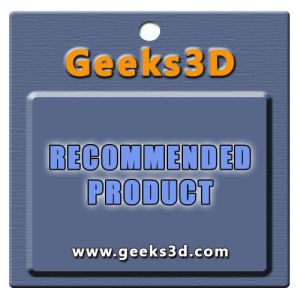ASUS Radeon HD 6670 review index
- Page 1 – ASUS HD 6670: Presentation
- Page 2 – ASUS HD 6670: Features
- Page 3 – ASUS HD 6670: OpenGL Tests
- Page 4 – ASUS HD 6670: Direct3D Tests
- Page 5 – ASUS HD 6670: Gaming Tests
- Page 6 – ASUS HD 6670: Power Consumption and Temperature
- Page 7 – ASUS HD 6670: Conclusion
7 – ASUS Radeon HD 6670: Conclusion
The Radeon HD 6670 is the refresh of previous Radeon HD 5670. The HD 6670 is small card that does not require high end PSU (no power connector) and then can find its place in entry level systems. The card can run latest 3D applications (OpenGL 4 or Direct3D 11). Of course you won’t get a smooth frame rate in latest games (expecially those including tessellation) but with more than 40FPS in DiRT 2 or Crysis, you can play with many games published these last years in full HD resolution. Cool for a $100 graphics card.
This card is also a good candidate for a HTPC usage even if I found the VGA cooler a bit noisy at default fan speed (39%). A simple solution is to reduce a bit the fan speed. I tested the HD 6670 under FurMark with a fan speed set to 30%. I ran a stress test during 20 min. At 30%, the noise level is very low, imperceptible, and the max GPU temperature doesn’t exceed 72°C (great especially if you consider the factory-overclocked GPU: +80MHz). Under normal situations, a fan speed of 30% is enough to properly cool the card. But I recommend you to let the default value (39%) if you have some doubts about the ambient temperature in the case or the usage of the card. At idle and with a fan speed of 30%, the GPU temperature is around 31°C which is nice!

I’d like to thank Roland from ASUS for the HD 6670 sample 😉
ASUS Radeon HD 6670 review index
Great review. Thanks.
This Full HD is a bit funny res, i will better wait for 16:10 LCD / 1920×1200 and prices to comedown.
You say it competes with the GT440 (~75$) and GTS450 (>110$) and costs 100$. Still you only list the GT440 in the benchmarks (which obviously is slower).
To me the numbers give the impression that a GTS450 is the better decision.
@jK: you’re right, according to other tests over the Net, the GTS is a very nice alternative to the HD 6670. But I didn’t talk about the GTS 450 for two reasons: I don’t have a GTS 450 so I can’t compare performances, and the GTS 450 requires an additional power connector. Both GT 440 and HD 6670 do not have power connectors.
Yes and they both have about 12k in 3Dmark06 overall performance and they both have prices bellow 100$, so you won’t be running Physx on full HD so Radeon would be better choice here.
GTS 450 – 1Gb DDR3 99.90€
GT 440 – 1GB DDR5 (slow card) 99.90€
HD 6670 – 1GB DDR5 (fast card) 99.90€
Now who winns?
^^ HD 6670 ^^ ABS THE BIG WINNER
I feel that the power draw conclusion is a bit off.
Idle, total power cons. 92W.
FurMark, total power cons. 194W
(194 – 92) * 0.9 = 92W
That would mean that the CPU and the rest of the system does not use any more power when the GPU is stress tested. I think the 66W TDP is pretty accurate, as the manufacturers have no need to understate those figures. Also, I doubt that the PSU has 90% efficiency at sub 200W.
@Sturla:
Yes, you are correct about the efficiency number. It’s around 0.85 ~ 0.88 at that low wattage. Doing the calculations again, it results that the Radeon 6670 is about 87 ~ 89 watts in full load. Wich isn’t that far off from 92.
But there is one thing you are wrong. Furmark stresses ONLY the GPU. You have normal 1~5% cpu usage while running Furmark so you can’t blame the system using more power during stress test. And even if there were some light usage of CPU, power draw would still be in the range of 80W, somewhat over the limit of what a PCi-Ex can handle. The only con I see to this is that you can’t overclock the card. Other than that, the numbers are perfectly fine 🙂
The review doesn’t speak about CrossfireX potential. I have an A10 based machine and want to know how this will perform in Crossfire. My understanding is that you have to master off the A10, but that you can get theoretical boosts equal to some percentage of this cards performance in cross fire mode, making the machine quite capable for low power and cost. Any attempt to evaluate Crossfire or expectations?